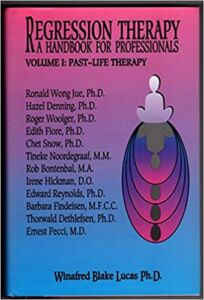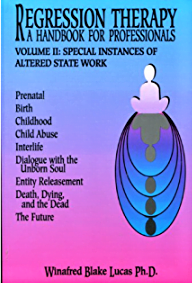 Reviewed by Thelma B. Freedman, M.A.
Reviewed by Thelma B. Freedman, M.A.
In JRT Issue 11, 1993
To say that this two-volume compendium is a major contribution to our field is to ridiculously undervalue it. It is, in this reviewer’s opinion, probably the most important single contribution to our field to date. More than ten years in the making, it reflects the precision, thoughtfulness, and thoroughness that one would expect from Lucas.
 Both volumes are elegantly organized. The first ten chapters of the first volume, written very sensitively by Lucas, constitute an overview of the field as it has grown and stands today. The first chapter is exactly what it should be: an excellent history of past-life therapy. In the next nine chapters, Lucas discusses the theories, assumptions, and techniques of our field, including our many controversies and dilemmas. These chapters pull together the various (and sometimes conflicting) views of the 13 contributors whose papers comprise the remaining 12 chapters of Volume I.
Both volumes are elegantly organized. The first ten chapters of the first volume, written very sensitively by Lucas, constitute an overview of the field as it has grown and stands today. The first chapter is exactly what it should be: an excellent history of past-life therapy. In the next nine chapters, Lucas discusses the theories, assumptions, and techniques of our field, including our many controversies and dilemmas. These chapters pull together the various (and sometimes conflicting) views of the 13 contributors whose papers comprise the remaining 12 chapters of Volume I.
These papers have been written by 13 of the earliest and leading practitioners of past-life therapy. The chapters all follow the same basic format; in the first section we learn the writer’s background and by what stages he or she came independently to past-life therapy. These biographical sections are, to me, fascinating. Cumulatively, they convey the effect of what some Eastern philosophies call a “karass:” a group of people whose karma is to find each other to accomplish some great goal together. Perhaps to other working therapists, who may already have acquaintance with some of the theories and techniques discussed in the rest of these chapters, this human, biographical material will also be of special interest. Here we see 13 highly respected therapists and independent thinkers on their lonely, years-long journeys and quests.
This first, biographical, section is followed in each chapter by more pragmatic material. The second section of each paper gives us the writer’s theories, including his or her philosophical hypotheses, therapeutic assumptions, and beliefs about the indications and contraindications for the use of past-life therapy. The third and fourth sections of each paper cover each writer’s techniques for induction and processing material, all described in great and useful detail; also included here is a discussion of failures, thoughtfully analyzed by each writer. These sections are followed by case descriptions illustrating the theories and techniques discussed. Taken as a whole, we see in these chapters a tremendous diversity of ideas and techniques, a richness of imagination in developing techniques that work, theories drawn from them, and new questions to ask.
This first volume focuses on past-life therapy. The second volume, as its subtitle indicates, moves into related areas. These include regression to prenatal, perinatal, birth, and childhood experiences, death and interlife experiences, progression to future lives, and releasement therapy. Chapters and sections are written by over 20 major practitioners and therapists in the various areas; each consists of a detailed introduction and one or more case analyses. Again, we see the diversity of opinion and techniques that marks our field’s development.
Klimo, in his Forward to this second volume, points out that it is not Lucas’ intent in these volumes to convince the skeptical, but rather to provide a comprehensive handbook and guide for therapists of past-life therapy and its related areas. Although Lucas has succeeded handsomely in this goal, she has also produced two volumes that may well (and should) shake some skeptics’ preconceptions, as well.
One major skeptics’ preconception that is challenged by these volumes is that these therapies are of little value and can be easily dismissed. This massive collection of papers by thoughtful, experienced therapists demolishes that preconception. The sheer intellectual weight of this collection demands attention. One may disagree with some points made, some assumptions and interpretations, or one may think that one technique is more useful than another. Indeed, it is impossible to agree with everything in these volumes. But it is also impossible to ignore the overall effectiveness of the therapies discussed, or the care with which they have been developed and are still being nurtured.
If I have a complaint about these volumes, it is that there is scant attention given to some of the research that has been done. The focus is on therapy, and this is in itself appropriate, given Lucas’ intent to create a “handbook for professionals.” Nevertheless, professionals need to know the research in their fields. Although Appendix C of Volume I describes Lucas’ fascinating “Mind Mirror” study, and some references to other research are embedded within Lucas’ first ten chapters, no separate chapter is devoted to research nor is all of the research that has been done mentioned. Although our field cannot boast very much research, what has been done is exciting. I would have liked to see such a chapter included, one in which the research done was described and critically analyzed.
I do like the discussions of contraindications and failures that are included, both by Lucas in her first ten chapters and by each contributor. Every field is defined by its failures, its limitations, as much as by its successes, and it is essential for professionals to know what doesn’t work as well as what does. A word of warning is in order, however. In a field such as ours, these contraindications and failures should not be taken as gospel because some new and creative technique may turn a failure into a success. This has been the story of our field as some therapist, faced perhaps with a failure, created a new technique that worked.
Lucas has indeed produced a handbook for professionals, but she has also produced an excellent training guide. Those teaching past-life therapy will, from now on, find these volumes essential; since they now exist, they immediately constitute the heart and soul, the absolute foundation stone, of all good courses.
It is this reviewer’s opinion that all past-life therapists and teachers should own this handbook. It is a source book for ideas, novel approaches, and different ways to use past-life therapy. These volumes are not meant to be read once and put on a shelf; they are meant to be an everyday resource for practicing therapists who want to expand their own techniques and approaches, and for teachers who want to cover the field responsibly. Such a collection is rare in any field of therapy, and we are fortunate that Lucas and her many honored contributors have given us this one.
